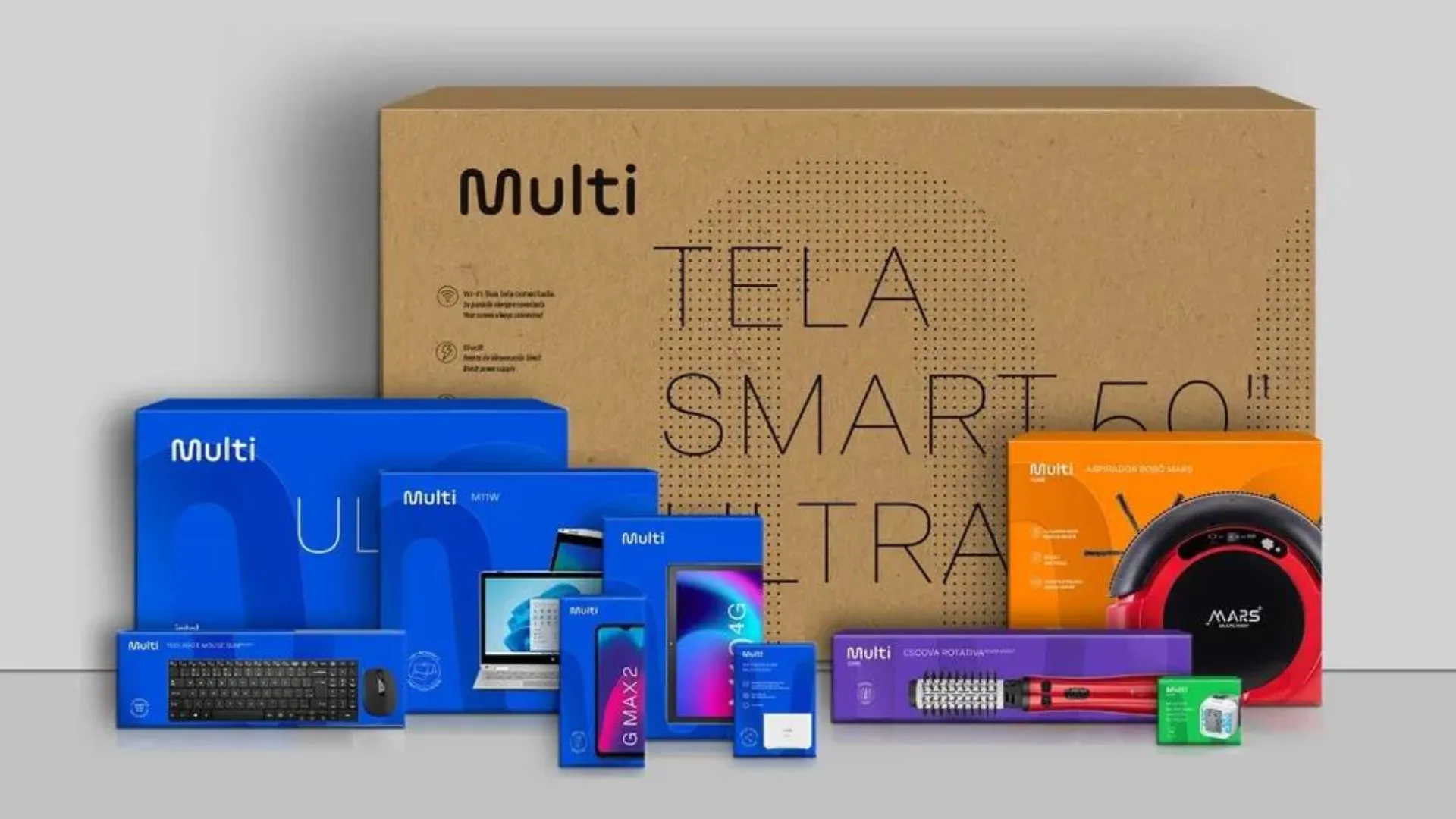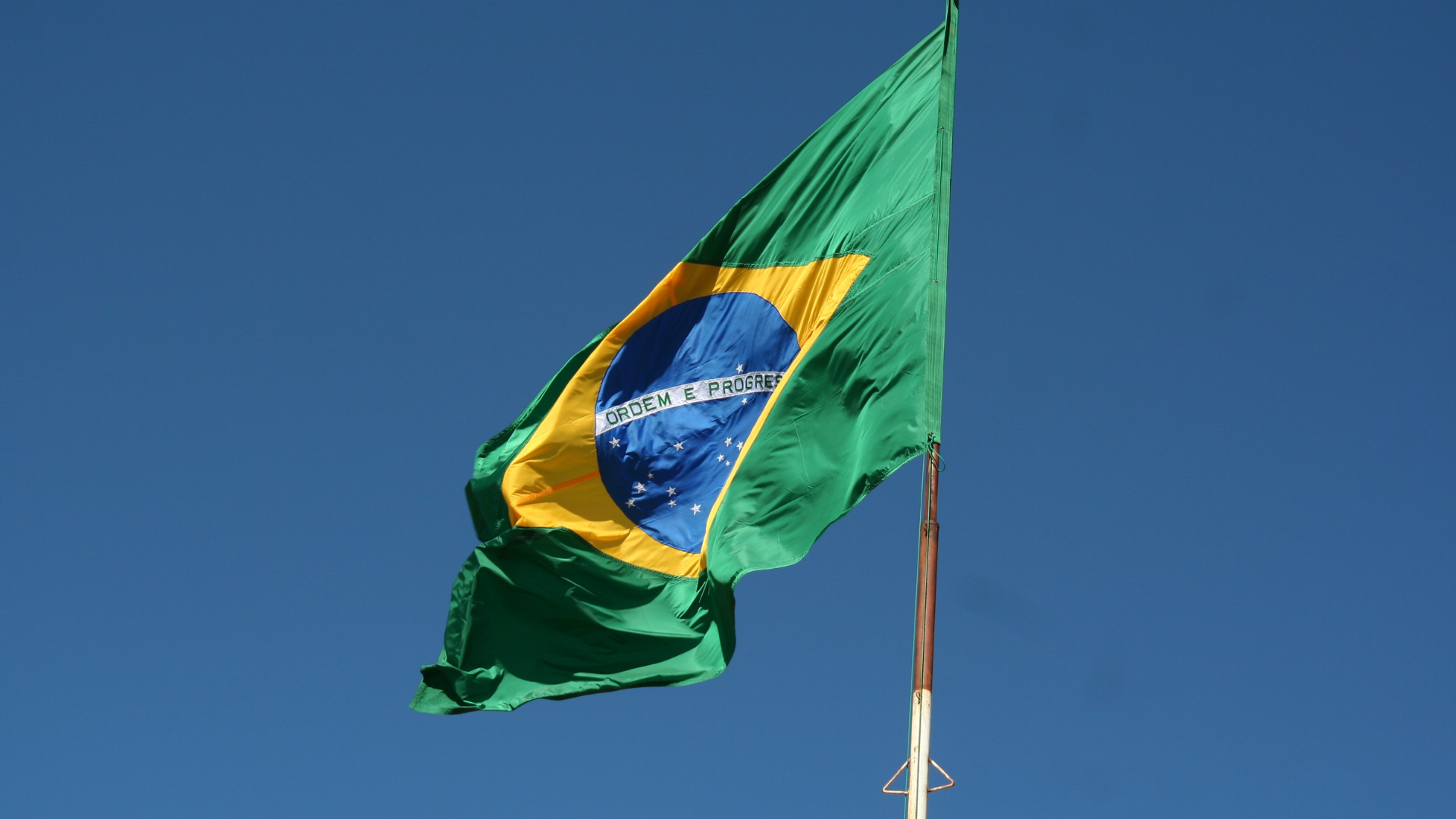Why do we invest in Multi?
Dear investors,
Something we like to evaluate are opportunities to invest in "cold elite athletes": businesses with excellent financial track records but that are undervalued due to poor results in the recent past, caused by some temporary event. Especially in times of weaker economic conditions, the market tends to overemphasize short-term results and heavily penalize companies with poor quarters. This creates opportunities to buy shares at low prices in companies that have a good chance of recovery simply by reversing their results to their historical average.
This type of investment requires a willingness to act against prevailing public opinion, something more difficult than one might imagine. Companies with poor recent results and falling stock prices are easy targets for criticism from market professionals. At a certain point, so many people criticize the stock that a stigma is created around the company, and many investors begin to dismiss the thesis without properly investigating its merits, simply assuming that the majority must be correct. In the case of professional managers, this also involves the reputational risk of investing in what the entire market believes is a bad idea and which would create an image of an avoidable error if the thesis were to suffer from poor results in the future.
Note that this type of stigma has no impact on the actual risk of a given business, but it can cause its share price to fall beyond what fundamentals justify, creating risk-return asymmetries that can offer unusually good investment opportunities. This is precisely the type of situation investors should investigate.
In this letter, we will share a summary of our investment thesis for Multi (formerly Multilaser), which fits what we just described: it has an excellent track record of results over the last 10 years, poor results in recent quarters, and is the target of disdain among most professional investors. In this context, its share price has fallen so much that a partial recovery to its historical results is enough for the investment to yield attractive returns.
Performance in the last decade
Multi began operations in 1987, selling refilled printer cartridges. By 2003, the company was a leader in its niche market, with annual revenue of around R$30 million. However, an unexpected event changed the course of the business: its founder, Israel Ostrowiecki, died in an accident while diving on a vacation. Then, Alexandre Ostrowiecki, his son, took over the company at just 23 years old, bringing in Renato Feder, his personal friend and the son of the entrepreneurs who led the Elgin group, as a partner to help him with the challenge of maintaining and developing the business.
In the following years, Multi began expanding its business, launching lines of computer accessories and electronic products imported from China under the Multilaser brand. The goal was to offer the Brazilian market technology products at very affordable prices and with superior quality control compared to goods imported from China, which competed in the same price range. To this day, Multi is closely associated with Multilaser computer accessories, which represent only a fraction of the company's total business. However, before delving into its current business model, let's look at the data that caught our attention and led us to study Multi's investment thesis.
Over the past 10 years, the company has averaged annual growth of 21.9%, with an average net margin of 11.7% and an average return on equity of 20.8% (including the poor year of 2022). See the historical annual results of this last decade illustrated in the charts below.
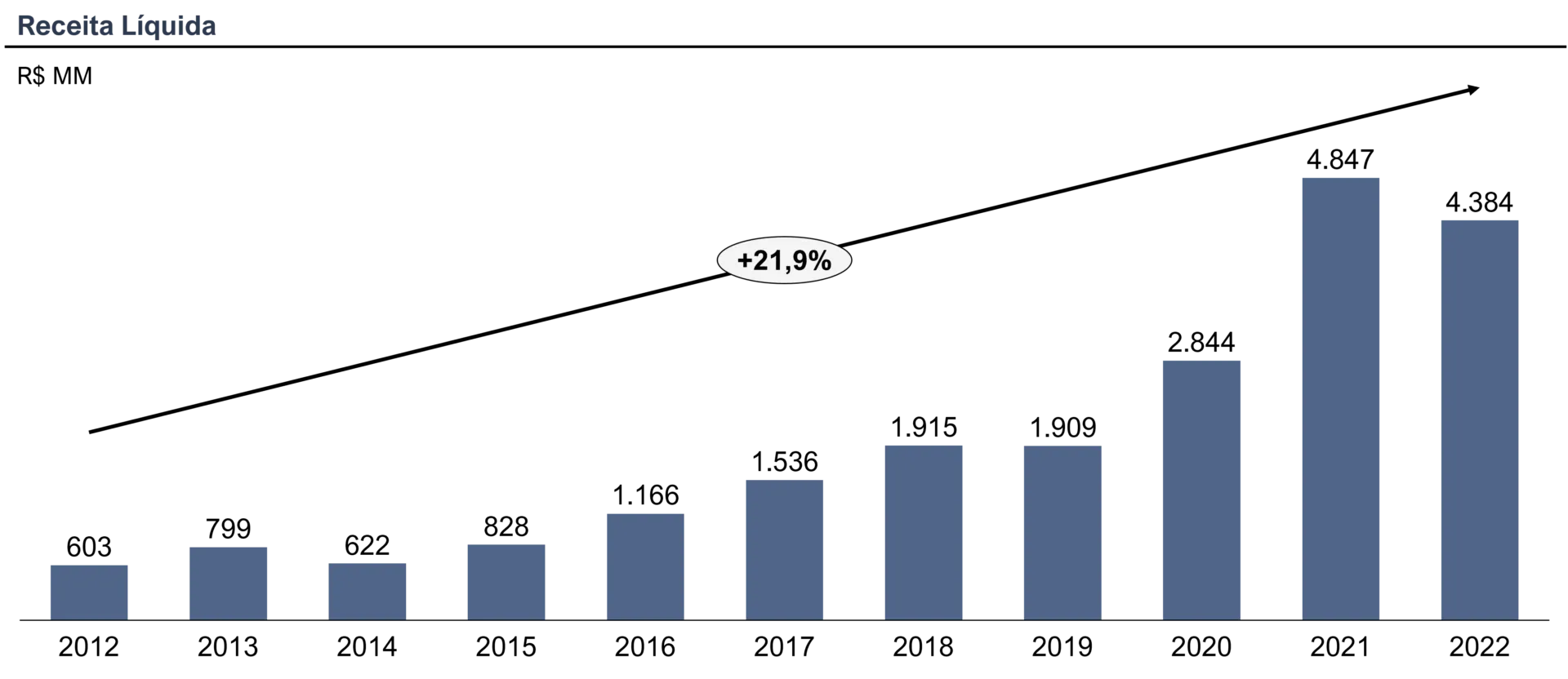
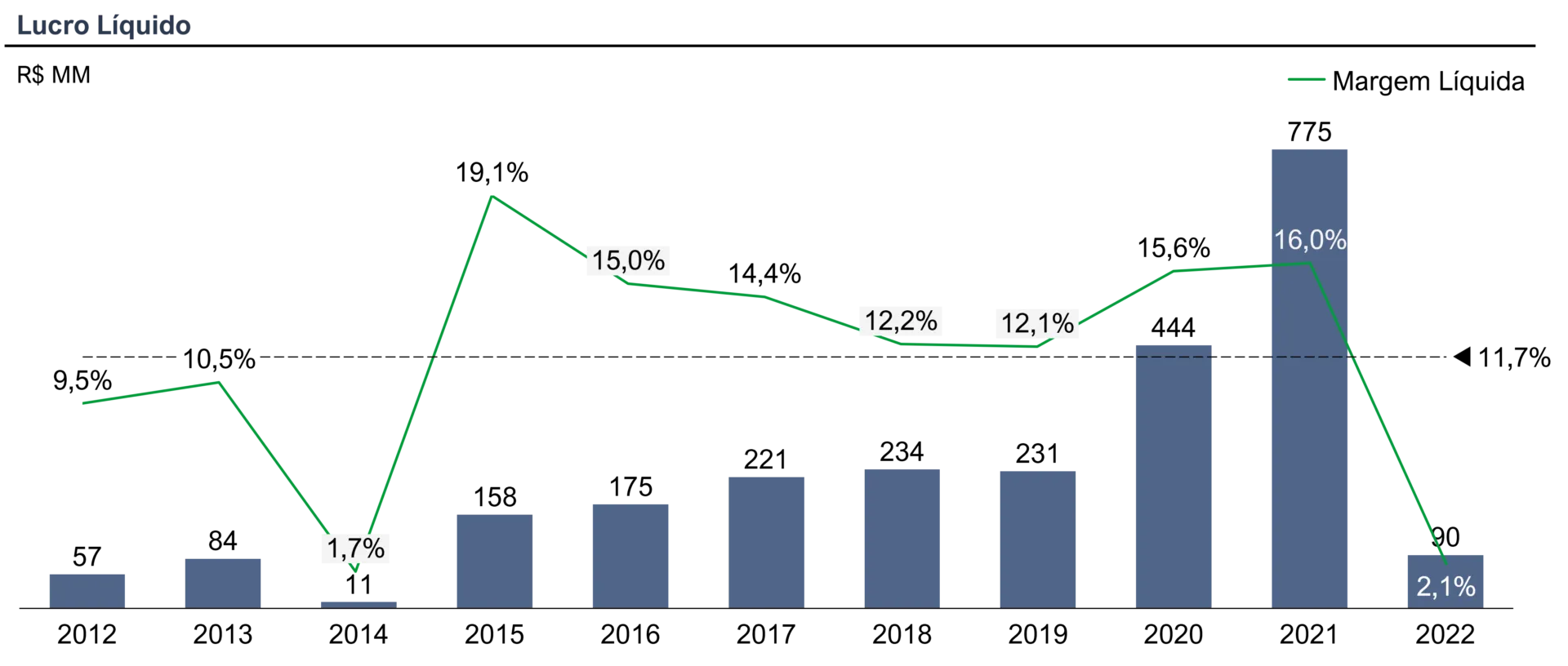
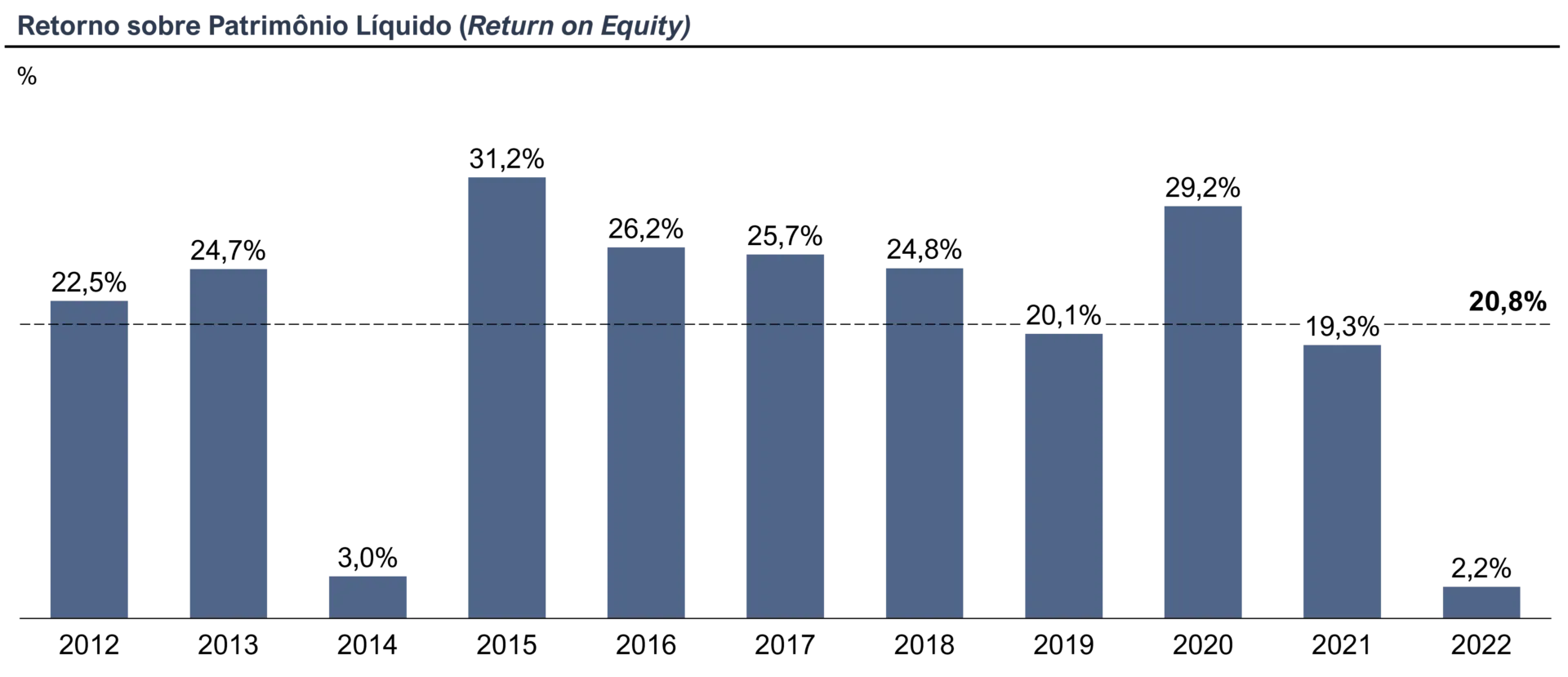
In addition to this excellent earnings track record, we're pleased that, in contrast to recent "unicorns" that grew rapidly while burning hundreds of millions in venture capital funding on loss-making operations, Multi has followed a more traditional trajectory: it has grown while maintaining good profitability over the years and reinvesting its own cash flow. If what we've presented so far has also caught your attention, let's explore Multi's current business.
What does Multi do today?
Multi is currently a major importer, manufacturer, and distributor of a wide range of consumer goods. Its portfolio includes over 7,000 product SKUs from 44 brands, including 20 of its own and 24 partner brands, several of which are distributed exclusively by Multi in Brazil. In addition to its well-known computer accessories, the company sells smartphones, notebooks, portable appliances, household appliances, tools, sports equipment, health and beauty products, telecommunications network equipment, automotive products, safety equipment, children's and pet supplies, and various other product categories. Indeed, Multi is a fitting name for the company.
Multi's customer base is also quite diverse. More than 30,000 customers sell Multi products at more than 44,000 points of sale. These customers include retailers of all sizes, distributors, companies that purchase large quantities directly, and government agencies through contracts won through competitive bidding processes. End consumers are also served directly through e-commerce channels.
The company's business model is based on its sales force and operational efficiency. It consists of identifying products linked to emerging technologies, developing relationships with manufacturers, many of them located in China, testing the products in its laboratories to ensure the expected quality, and importing them into Brazil at competitive costs. Some products are purchased ready-made, while others are assembled or manufactured in Brazil, sometimes to take advantage of tax benefits offered to companies with local production. By maintaining high operational efficiency and cost control, Multi is able to offer products at extremely competitive prices when compared to products of similar quality.
Note that this business model is relatively independent of the product categories in which the company operates. Multi has 12 business units that operate autonomously and handle very different product classes. Each unit has its own resources, marketing, and engineering, and senior executive compensation is tied to the return on capital employed in their unit. In addition to risk diversification, this decentralized operation also gives the company the flexibility to adapt to changing market demand profiles. In other words, if a particular product segment becomes unprofitable, the cost of abandoning it and replacing it with another segment is quite low. Even Multi's production and assembly lines are easily adaptable to produce a wide range of different products.
This versatility isn't theoretical. The company has already made significant changes to its product mix over time and maintained consistent financial results throughout the transformations in its portfolio. The discipline of continuously monitoring the profitability of each product and replacing those that don't reach target profitability with new products is ingrained in Multi's culture. We understand that this dynamic of continuous portfolio renewal in pursuit of profitability is one of Multi's key success factors.
However, the following question arises: if the business model is profitable, diversified, and adaptable, why has the company had such poor recent results and why has its valuation been so penalized by the market?
Recent results
The year 2021, in which Multi filed for an IPO on the Brazilian stock exchange, was quite atypical. Amid the lockdown, while several service and entertainment businesses suffered, several product segments experienced a period of increased demand: for example, people working from home began purchasing more portable appliances to facilitate their household routines, and more computers and IT accessories to equip their home offices. However, at the same time as this surge in demand, the import process of goods was much slower than usual, due to logistical issues and product shortages caused by production shutdowns. Multi reacted to this scenario in a way that, at first, made sense: it increased its inventory levels as needed to sustain the sales volumes it was achieving. This reaction later caused a severe backlash.
Multi has long maintained a robust inventory to quickly fulfill customer orders, a key differentiator for small retailers who lack sufficient working capital to maintain a large inventory. This practice worked well for years and appears to be appropriate for periods of predictable demand, but it has proven to be a dangerous strategy during periods of demand shock.
In 2022, after the lockdown was lifted and normality returned to normal, consumption of the aforementioned product segments returned to pre-pandemic levels, while Multi still maintained sufficient inventory to meet several months of supercharged demand. Due to weak demand, the company was forced to conduct aggressive inventory clearances, which destroyed its profitability in Q4 2022 and Q1 2023.
In addition to this problem, in January 2023, the company migrated its ERP (from TOTVS to SAP) and experienced a severe operational problem in the new implementation, which was resolved in the following two months, but prevented the company from billing the usual volume of orders throughout the 1st quarter, strongly affecting its revenue in the period.
The inventory burndown and the ERP migration issue combined led to Multi's R$548 million loss in these two quarters. This undoubtedly represents significant value destruction. However, before judging whether Multi's shares are worth investing in, two important questions arise: i) will the company's loss have a temporary or lasting impact? and ii) does the current share price accurately reflect the company's earnings expectations?
Was the evil temporary?
The first question is the most important. If a business undergoes a structural transformation, its historical results become irrelevant for predicting its future. A well-known example is the story of Kodak, which was successful for over 100 years but quickly succumbed after the advent of digital cameras. So, let's investigate the two problems Multi faced.
The biggest problem was the excessive purchase of items that experienced supercharged demand during the pandemic. After making these purchases, the company had only two options: continue selling at normal prices until inventory levels returned to normal, or sacrifice margins to burn through excess inventory more quickly. Since much of Multi's inventory consisted of technology products, which lose value over time and can become "stale" (because they become obsolete), the chosen alternative was to burn through inventory as a corrective measure. Despite the damage, we don't believe this inventory sizing error will lead the company to further excessive purchases, burnthroughs, and negative margins. Besides not being a systemic problem, since new product purchases are not dependent on past purchasing decisions, the memory of the recent error is a certain antidote against repeating it in the near future. So much so that Multi is already moving in the opposite direction: it has been taking strict measures to reduce purchases and take less risk on the products it selects to keep in stock.
The second problem is easier to analyze. ERP migrations are non-recurring events, and SAP, the system to which Multi migrated, is often the definitive ERP adopted by large companies, meaning that decades can pass before a new migration is necessary. In this context, it matters little whether the problem was inevitable or due to the company's inability to replicate this process, as future business results are largely independent of the ability to repeat this process. One concern we had was the reputational damage caused by delayed deliveries to small retailers, but the vast majority of them had long-term relationships with Multi, understood that the situation was temporary, and did not lose their customers because of what happened.
From this perspective, we believe it's correct to conclude that Multi hasn't undergone any transformations that will have a lasting negative impact on its future. Despite recent poor quarters, the company continues to operate with the same business model that generated very positive results over the last decade, under the leadership of the same CEO who created the company's successful track record. He maintains a ~40% stake in Multi to this day, and during the share price decline following the weak results, he purchased a significant volume of shares, signaling his confidence in the business. Furthermore, the latest quarter's figures already show a good recovery in profitability and strong cash generation, indicating that the worst is over.
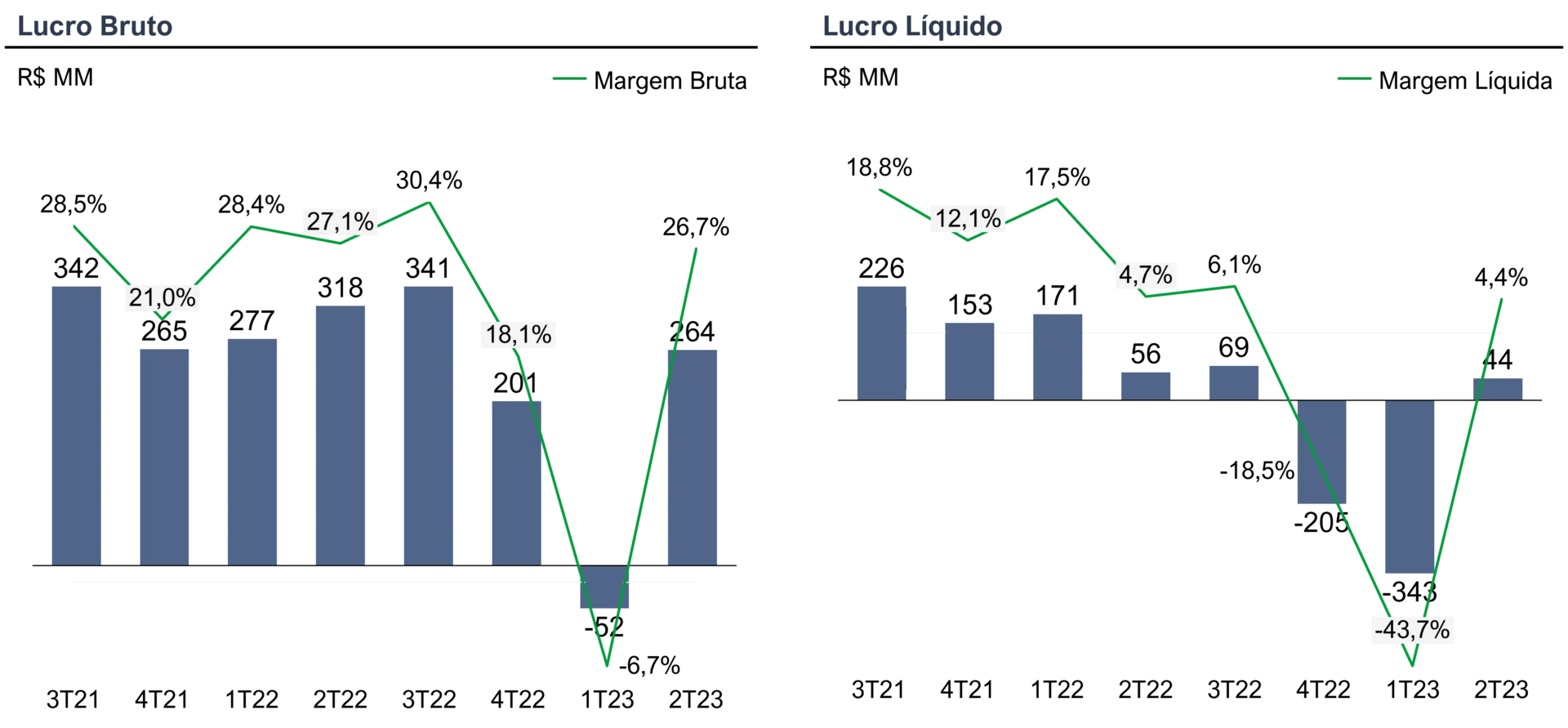
Are Multi shares cheap?
Estimating a company's value with a reasonable margin of accuracy requires detailed projections of its financial results and estimates of how much cash flow the business will generate for its shareholders in the future (discounted cash flow method). However, it's possible to get a sense of the minimum value of a business through less precise but quicker and easier-to-understand analyses. That's what we'll do here, presenting a very simplified analysis.
Multi had net revenue of R$4 billion in the last four quarters. It's reasonable to assume this revenue level is sustainable, as Brazilian retail was slow during this period, and some months saw revenues hampered by the ERP migration issue. As a reference, the company already achieved net revenue of R$4.85 billion in 2021, 21% higher than the current level. Using the company's average net margin of R$11.7% over the last 10 years, Multi's normalized net profit would be R$468 million.
Today, Multi is valued at R$2.67 billion on the stock exchange (R$3.26 per share on September 4), which would be equivalent to a price-to-earnings multiple of 5.7x. Compared to this figure, the average price-to-earnings multiple for companies listed on the B3 (formerly Petrobras and Vale) is 12.4x, from January 2005 to July 2023. Another benchmark is that listed companies that sell products similar to part of Multi's portfolio (Intelbras, Positivo, and Allied) traded at average price-to-earnings multiples of 11.6x over the past two years. Given these benchmarks, Multi would currently be valued at a discount of around R$501.03. It would also be arguable that its multiple should be higher than the average multiple on the Brazilian stock exchange, as its growth rates are higher than those of most other listed companies.
From another perspective, Multi's current equity on the balance sheet is R$3.75 billion. If it were able to generate a return on equity at the historical average of R$20.81, the net profit generated would be R$781 million. If we are more conservative and assume a future return on equity of R$151 (R$281 below the historical average), the company would still generate R$563 million in profit, and the implied price-to-earnings multiple would be 4.7x.
A third check is to evaluate Multi's profits generated over the past five years, adjusted by the IPCA, to estimate the corresponding values in currency equivalent to the Brazilian Real in 2023. This period includes three years before the IPO, before Multi raised R$1.9 billion to invest in business growth, and 2022, when its profitability was affected by the inventory clearance. Even so, the average profit level in the period was R$428 million, which would lead to an implied Price/Earnings multiple of 6.2x.
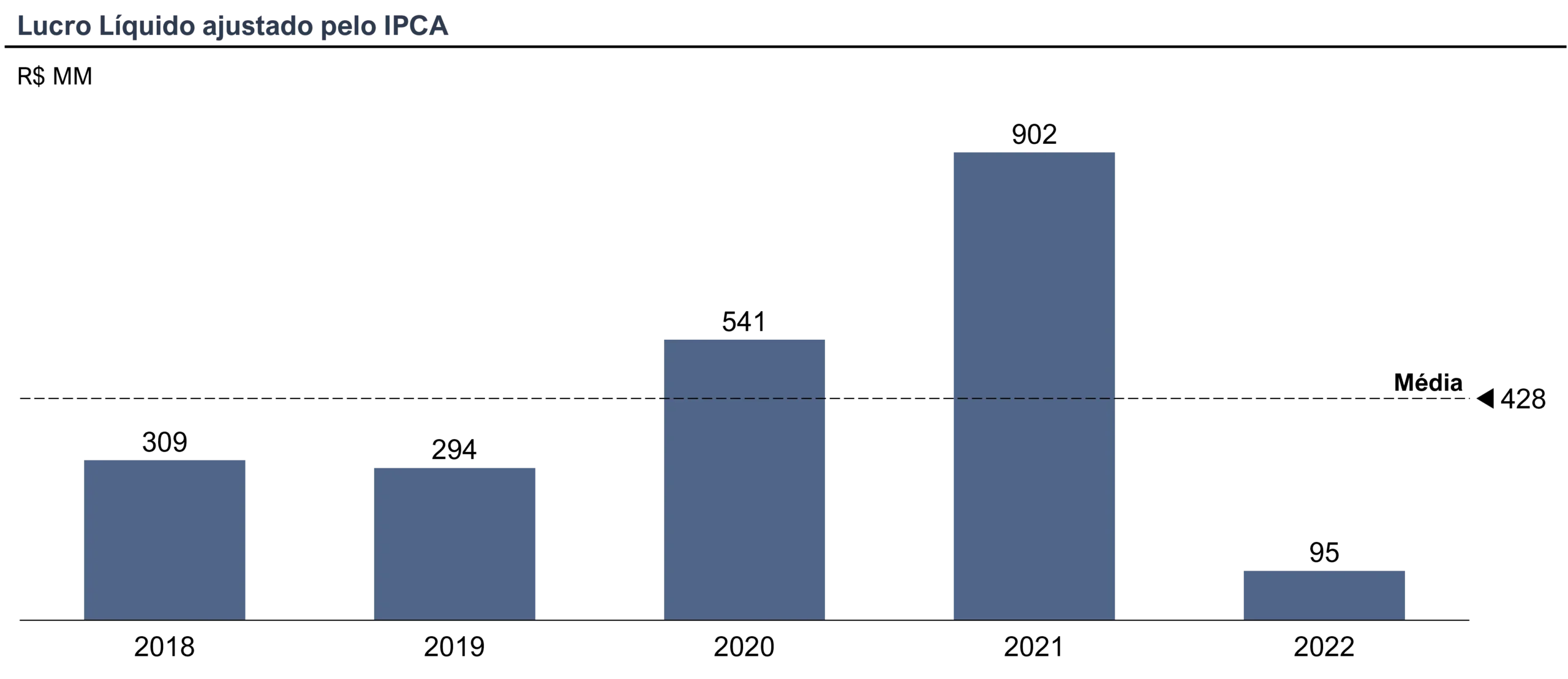
Regardless of the perspective, it's clear that Multi shares are quite cheap. If the company grows half of its past growth rate and recovers profitability even remotely close to its historical level, there will already be a significant appreciation compared to the current share price. If Multi returns to its historical performance, growing more than 20% per year with a return on invested capital of more than 20%, the potential return on investment is enormous.
Although the analyses presented here are quite simplified, the results of our detailed analyses point in the same direction.
Final considerations
Like any thesis, this one has its risks. The main ones are the possibility that Brazilian retail will continue to sluggish, which could harm both sales volume and margins, and the risk that some tax change, amid the various measures the current government has been trying to implement to increase revenue, could negatively impact the company. However, Multi's current share price seems so far below what would be reasonable that the investment could yield an attractive return even if some negative events with a moderate impact occur.
Another consideration is that we tend to spend much more time analyzing risks than potential positive outcomes, but Multi has invested in several initiatives that could yield results beyond our projections. For example, the company recently established several partnerships with internationally renowned brands, began producing portable appliances, and entered the electric motorcycle market. These initiatives are still in their infancy and generate revenue that is not significant for the business as a whole, but they could grow quickly and become significant additions.
We give little weight to these positive factors because it's common for investors to get carried away with the possibility of exceptional gains and overestimate the likelihood of optimistic scenarios materializing. We prefer to take a more cautious approach: focusing on the risks of each investment, estimating the business value based on normalized average results, and requiring a reasonable margin of safety in the entry price for new theses. If unforeseen positive events occur over time, they will always be welcome surprises.

